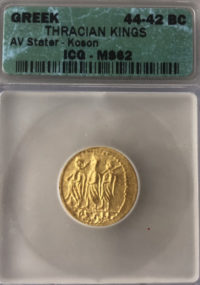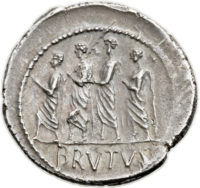 An anonymous donor dropped an ancient gold coin into a Salvation Army bucket in Florida on Friday morning. The gold stater from the 1st century B.C. was wrapped in one-dollar bill and dropped in the ubiquitous red kettle in front of a Publix grocery store in Tampa. A coin dealer estimated its market value at around $2,000.
An anonymous donor dropped an ancient gold coin into a Salvation Army bucket in Florida on Friday morning. The gold stater from the 1st century B.C. was wrapped in one-dollar bill and dropped in the ubiquitous red kettle in front of a Publix grocery store in Tampa. A coin dealer estimated its market value at around $2,000.
The obverse of the coin depicts three togate men, a Roman consul flanked by two fasces-bearing lictors. They are walking facing left. The word “ΚΟΣΩΝ” inscribed under them. The reverse has the image of an eagle standing on a scepter clutching a wreath in one claw.
The Independent Coin Graders label says it’s a “Greek Thracian Kings” coin dating to 44-42 B.C. but that’s a disputed identification. The coin was not minted in Greece. This type of stater has only been found in Transylvania, often in large hoards. Koson is believed to be name of the Dacian king who minted the coin, but his name and reign are otherwise unrecorded. Some scholars think he might be the same person as a king Cotiso or Cotison mentioned by historians Appian and Suetonius as having rejected Octavian’s offer of a marriage alliance and sided with Antony in the civil war and by the poet Horace as having been defeated in battle by Octavian.
Those events took place at 35 B.C., however, and the design of the coin suggests a connection to the previous generation of Roman civil warriors. The consul flanked by lictors is very similar to the reverse of a coin minted by Marcus Junius Brutus in his role as moneyer a decade before he assassinated his way into history. It depicts his ancestor, Lucius Junius Brutus, revered for having overthrown the last Tarquin king of Rome and considered the founder of the Roman Republic, as the first ever consul of  Rome in 509 B.C. It’s possible Koson modeled his stater after the 54 B.C. Brutus denarius as a tribute because he was a supporter of the latest Brutus to claim the status of liberator and tyrannicide. The 44-42 B.C. date would put it right in the middle of the wars after the assassination of Julius Caesar.
Rome in 509 B.C. It’s possible Koson modeled his stater after the 54 B.C. Brutus denarius as a tribute because he was a supporter of the latest Brutus to claim the status of liberator and tyrannicide. The 44-42 B.C. date would put it right in the middle of the wars after the assassination of Julius Caesar.
The Dacian kingdom had fallen apart in 44 B.C. and the territory was splintered into numerous conflicting tribal factions. If there was a Thracian king involved, he must have minted these coins specifically to pay Dacian tribesmen, perhaps for raids across the Danube.
The coin has been graded (MS-63), meaning it’s in mint, uncirculated condition with only minor deficiencies in the strike, not due to wear and tear. In this example you can see the obverse image is off-center, enough so that the beaded border is missing from the left side, as is the K in Koson. The Salvation Army is working with a dealer to arrange for the conversion of this coin into spendable cash for its charitable endeavors.